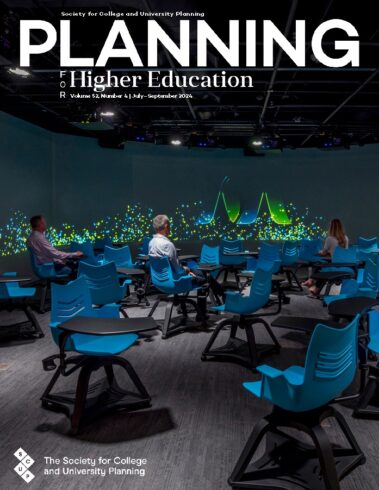- Integrated Planning
Integrated Planning
Integrated planning is a sustainable approach to planning that builds relationships, aligns the organization, and emphasizes preparedness for change.
- Topics
Topics
- Resources
Resources
Featured Formats
Popular Topics
- Events & Programs
Events & Programs
Upcoming Events
- Building Buy-in for Planning: Dealing With Resistance and Gaining Support
Online | March 11 – April 8 - Budgeting for Impact: A Working Group on Resource Planning in Higher Education
Online | Feb 5, Feb 19, March 5 - Cross-Functional Collaboration: Tools and Skills for Working Across Silos
Online | February 10, 17, 24
- Building Buy-in for Planning: Dealing With Resistance and Gaining Support
- Community
Community
The SCUP community opens a whole world of integrated planning resources, connections, and expertise.
- Integrated Planning
Integrated Planning
Integrated planning is a sustainable approach to planning that builds relationships, aligns the organization, and emphasizes preparedness for change.
- Topics
Topics
- Resources
Resources
Featured Formats
Popular Topics
- Events & Programs
Events & Programs
Upcoming Events
- Building Buy-in for Planning: Dealing With Resistance and Gaining Support
Online | March 11 – April 8 - Budgeting for Impact: A Working Group on Resource Planning in Higher Education
Online | Feb 5, Feb 19, March 5 - Cross-Functional Collaboration: Tools and Skills for Working Across Silos
Online | February 10, 17, 24
- Building Buy-in for Planning: Dealing With Resistance and Gaining Support
- Community
Community
The SCUP community opens a whole world of integrated planning resources, connections, and expertise.
 Planning for Higher Education Journal
Planning for Higher Education JournalFrom Awareness to Acceptance to Action
Build a Neuroinclusive Campus Community From Volume 52 Number 4 | July–September 2024By Hilary Meyer, MBA, MLISPlanning Types: Diversity, Equity, and Inclusion Planning, Strategic PlanningChallenges: Student Success, Retention, and Graduation, Resolving Inequities, Engaging Stakeholders, Planning AlignmentTags: Accessibility, Alignment, Analyzing Stakeholders, Community College, Diversity Equity and Inclusion (DEI), Engaging Stakeholders, Implementation, Informal Learning Environments, Innovation, Library, Operational Planning, Professional Development, Selecting Metrics, Student Support Services, Underserved Students, Workforce Development
From Volume 52 Number 4 | July–September 2024By Hilary Meyer, MBA, MLISPlanning Types: Diversity, Equity, and Inclusion Planning, Strategic PlanningChallenges: Student Success, Retention, and Graduation, Resolving Inequities, Engaging Stakeholders, Planning AlignmentTags: Accessibility, Alignment, Analyzing Stakeholders, Community College, Diversity Equity and Inclusion (DEI), Engaging Stakeholders, Implementation, Informal Learning Environments, Innovation, Library, Operational Planning, Professional Development, Selecting Metrics, Student Support Services, Underserved Students, Workforce Development
Institutions referenced in this resource:
Triton CollegeTriton College’s strategic plan focuses on short- and mid-term institution-wide neurodiversity efforts to create a neuroinclusive campus culture. Key aspects of success include a multi-year administrative commitment; connecting the work to the open-access mission; including committee members from across the college; and focusing on programming, space, and partnerships. Triton College built support and overcame barriers by amplifying advocates and identifying champions, tying the work to campus-wide initiatives, ensuring strategic and operational leadership, securing seed funding, including stakeholders, starting small, reducing risk, allowing for development time, defining the work, building on wins, and adhering to an open-access mission.
MEMBERS ONLY
Attention Members: Log in to access this item.Not a member? Join now to access this article and all journal articles for free. - Topics
- Topics


